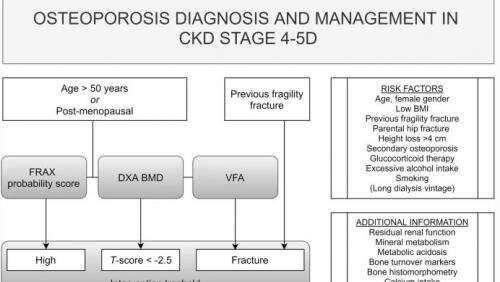New guidance on how to diagnosis and manage osteoporosis in chronic kidney disease

Patients with advanced chronic kidney disease (CKD) typically suffer from impaired bone quality and quantity, with a non-vertebral fracture risk which is 4-to 6-fold higher than the fracture risk of matched controls. However, despite their high risk of fragility fractures, the vast majority of patients with chronic CKD stages 4 to 5D, are not receiving osteoporosis therapy.
A newly published review by the International Osteoporosis Foundation (IOF) and European Renal Association-European Dialysis and Transplant Association (ERA-EDTA) CKD-MBD working group now provides concise recommendations, with a clear management algorithm, to support clinicians' knowledge and confidence in managing osteoporosis in their patients. The review summarises the recent 'European Consensus Statement on the Diagnosis and Management of Osteoporosis in Chronic CKD Stages G4-G5D'. It outlines essential information on the diagnosis of osteoporosis; risk factors for fragility fractures; assessment of fracture risk; intervention thresholds for pharmacological intervention; non-pharmacological and pharmacological intervention; monitoring; and systems of care. The review also points to key research questions and future perspectives, and recommends that fracture liaison services integrate systematic identification and management of CKD patients with fragility fractures, in close collaboration with nephrologists as part of the multidisciplinary team.
Lead author, Dr. Pieter Evenepoel, Department of Nephrology of the University Hospitals Leuven, Leuven, Belgium stated that "clinicians treating chronic kidney disease patients are often unsure about how to optimally manage bone health, resulting in inaction and a 'wait and see' approach in regard to preventative osteoporosis care. Now that recent studies suggest a similar efficacy of common osteoporosis drugs in patients with CKD stages G4-G5D as in the general patient population, it is time to foster a paradigm shift with regard to osteoporosis care in these patients. We hope that this succinct new review will serve to boost physicians' knowledge and confidence in managing osteoporosis in their patients."
Professor Serge Ferrari, co-author and Vice-Chair of the IOF Committee of Scientific Advisors, added that "the number of people with advanced chronic kidney disease (CKD) and undergoing maintenance dialysis is rapidly increasing around the world. We expect that these pragmatic recommendations, which result from a successful collaboration between European societies, will help to stimulate a proactive and cohesive approach to the management of osteoporosis in this growing subset of patients at high risk of debilitating fragility fractures."
More information: P. Evenepoel et al, Diagnosis and management of osteoporosis in chronic kidney disease stages 4 to 5D: a call for a shift from nihilism to pragmatism, Osteoporosis International (2021). DOI: 10.1007/s00198-021-05975-7




















